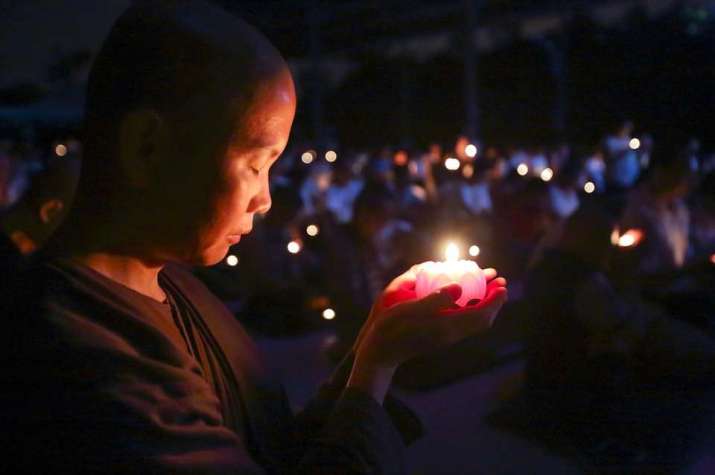
When one begins learning the process of meditation, there are a number of things one must first be aware of, and preparations one should make. Since no one rooted in this world is as yet perfect, the Buddha saw that before one can attain and maintain mindfulness (Pali: sati), one has to develop a firm foundation in morality (sila) on the Noble Eightfold Path.
The Five Precepts
First, the lay meditator should observe five precepts as a foundation for morality in daily life. These precepts are observed by lay people who visit meditation courses, those who go to temples to make offerings, and by lay followers on full-moon days. These five precepts provide at least a basic starting point from which to develop and provide enough sila to give sati a foundation upon which to rest and then begin to develop.
Translated directly from the Pali, they are as follows:
1. I undertake to observe the precept to abstain from killing living beings.
2. I undertake to observe the precept to abstain from taking what is not given.
3. I undertake to observe the precept to abstain from sexual misconduct.
4. I undertake to observe the precept to abstain from false speech.
5. I undertake to observe the precept to abstain from intoxicating drinks and drugs causing heedlessness.
In his book released by the Buddhist Publication Society, The Five Precepts (1976), Dr. Paul Dahlke translated and condensed the five precepts into more compact English:
Not to take the life of any living being.
Not to take what is not given.
Abstaining from sexual misconduct.
Abstaining from wrong speech.
Abstaining from intoxicants.
If one does not yet know where to start practicing sila, these are the five basic precepts one may “undertake to observe,” voluntarily, as a preliminary set of guidelines to follow, for one’s own good and development.
Following the precepts is an effective means of abstaining from the kind of behavior one observes in everyday worldly life, which one too often unconsciously follows and then becomes drawn into, if one is not heedful.
At first, it may be hard not to act impulsively, the way that people commonly do, but if one becomes capable of observing the precepts, this may serve as the basis for an improvement in one’s attitude—thus avoiding the sort of problems that plague people rooted in the common, everyday, worldly life; samsara.
Once one’s practicing the precepts begins to “feel right,” one will want to continue following them in order to maintain a developing sense of well-being, which is consequentially arising. When this begins to work, it is time to follow the Eightfold Path in closer detail.
Once one becomes more observant about not taking life, or stealing, or engaging in sexual misconduct, indulging in wrong speech, drinking alcohol, or taking drugs that cloud the mind and lead to unskillful conduct—once one realizes that this kind of abstinence actually leads to a much less complicated and happier life—one may be motivated to continue practicing on the path of sila until one reaches a point at which the mind has become pure enough to allow for the concomitant practice of mindfulness (sati), which will then begin to show further beneficial effects and encourage one to remain on the path.
Satisfied with the beneficial results of following the Five Precepts, one goes on to follow the Eight Precepts, which are adhered to by those who stay in temples as lay practitioners as a sign of their dedication to bodily and mental purity.
The Eight Precepts
1. I undertake the precept to refrain from destroying living creatures.
2. I undertake the precept to refrain from taking what is not given.
3. I undertake the precept to refrain from sexual activity.
4. I undertake the precept to refrain from incorrect speech.
5. I undertake the precept to refrain from intoxicating drinks and drugs that lead to carelessness.
6. I undertake the precept to refrain from eating at the improper time (i.e.) after noon.
7. I undertake the precept to refrain from dancing, singing, going to see entertainments, wearing garlands, using perfumes, and beautifying the body with cosmetics.
8. I undertake the precept to refrain from lying on a high or luxurious sleeping place.
There are also Ten Precepts, followed by novice monks and nuns, which split the precept on entertainment into two parts and add the final precept of refraining from handling money.
Whenever a new rule was added by the Buddha, there was always a reason for it: two cases in point are that refraining from all forms of sexual activity and handling money tend to make life much simpler and more free from outside influences connected to lust and greed.
The monastic rules (Vinaya)
Finally, those fully dedicated to the practice, in particular ordained monks, follow the 227 rules of the Vinaya, declared and explained by the Buddha, which serve as guidelines for monastic discipline and practice.
The Buddha’s laying down of rules was based upon arising situations, and there was always a good reason for what he said as it applied to the code of monastic training. Understanding why the Buddha made such rules is full of lessons intended for every monk’s moral guidance.

Addicted to rules and regulations
There are also householders who follow Buddhist rules and regulations and various ritual practices to the letter, making it a strict discipline that almost becomes a religion within itself. However, this should be seen as wrong view because rules and regulations ought not be made an end in themselves. They must be seen as meditation guidelines; intended as helpful pointers leading along the path to purity. Rules should be seen as meditation tools to be used as a means to an end.
The famous Thai monk Buddhadasa warned against practicing rituals for their own sake. He declared that the hope of accumulating merit through practicing ritual acts was comparable to accumulating money to be kept in reserve to be used for oneself in this life or another—and hence an example of wrong view.
On the contrary, the Buddhadhamma is based upon going within oneself, becoming an island unto oneself, and seeing things as they really are through constant mindfulness and ardent practice, and, in the end, transcending the need for rituals and ceremonies. Even the mind itself is just a meditation tool which, once it has been used for its purpose, can then be set aside.
It is worthy of note that, before his demise, the Buddha declared that there was no necessity for the monks to retain the bhikkhu’s minor rules because the way he taught was based upon practicing concentrated and meditative internal development. His teaching, when properly practiced, does not depend on blind adherence to external rules and rituals, but rather upon a clear understanding of how to extinguish the cause of suffering.
Through insight and wisdom, mental clarity evolves, based on right view and right understanding of the nature of impermanence (anicca) and the conceit of self (atta) and gradually one becomes an island unto oneself.
References
Dahlke, Paul. 1975. The Five Precepts. Kandy: Buddhist Publication Society.












